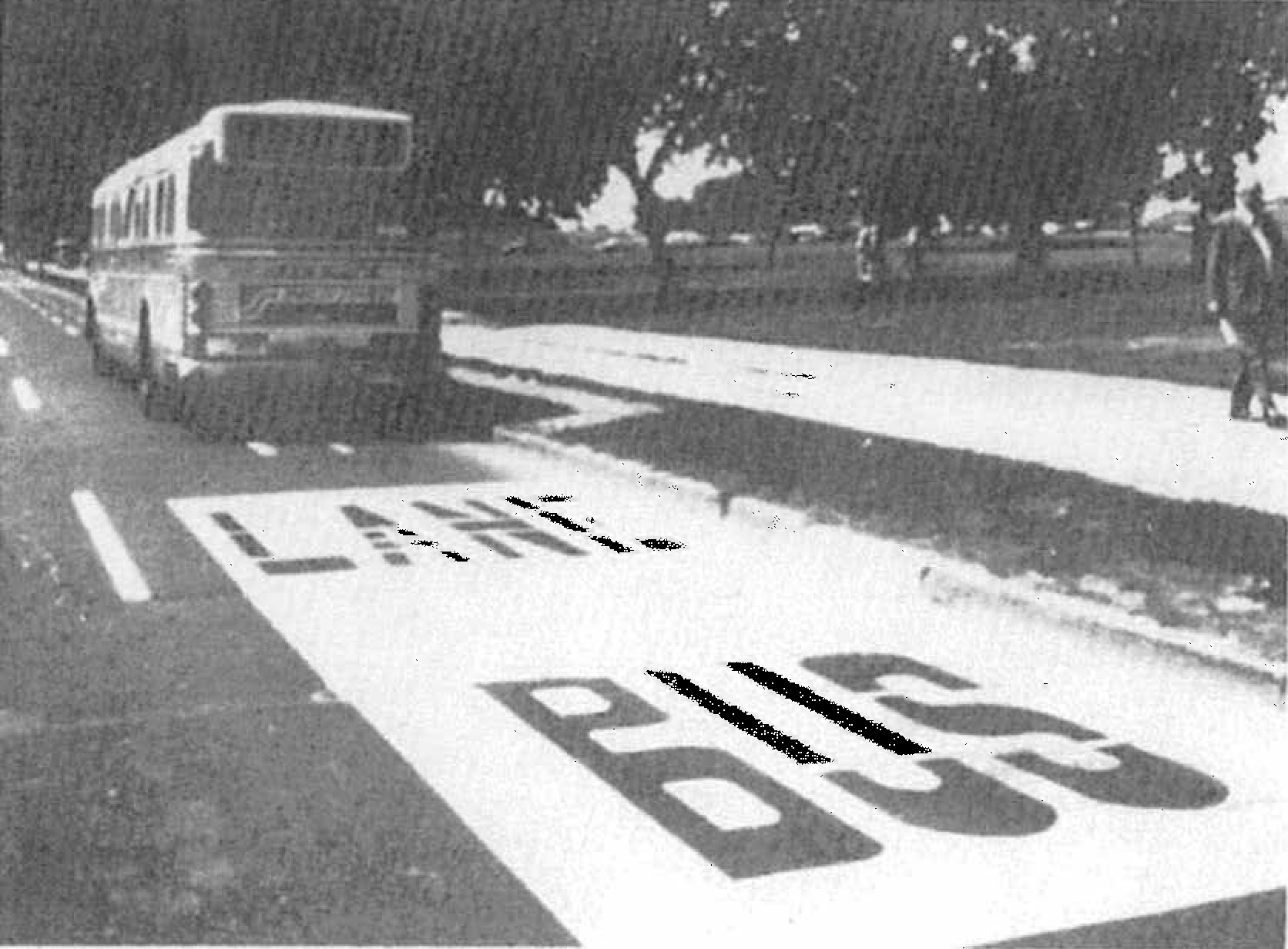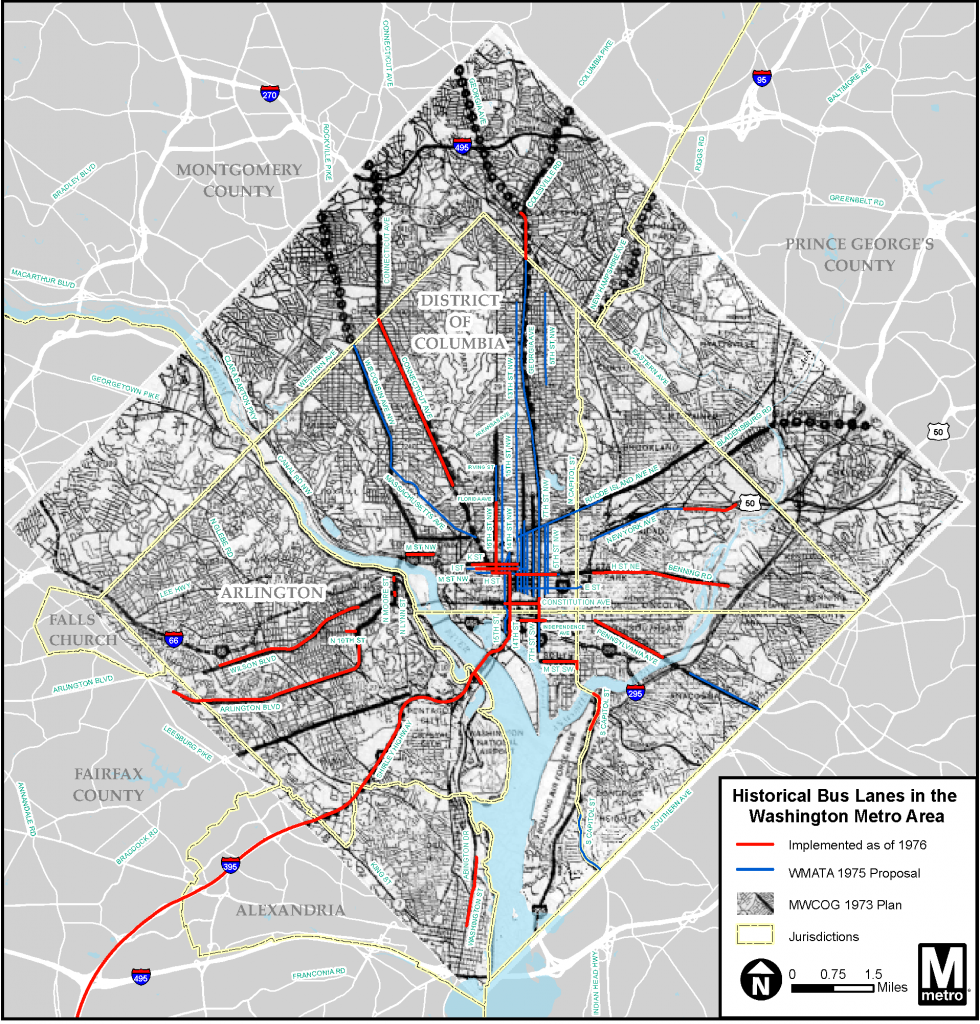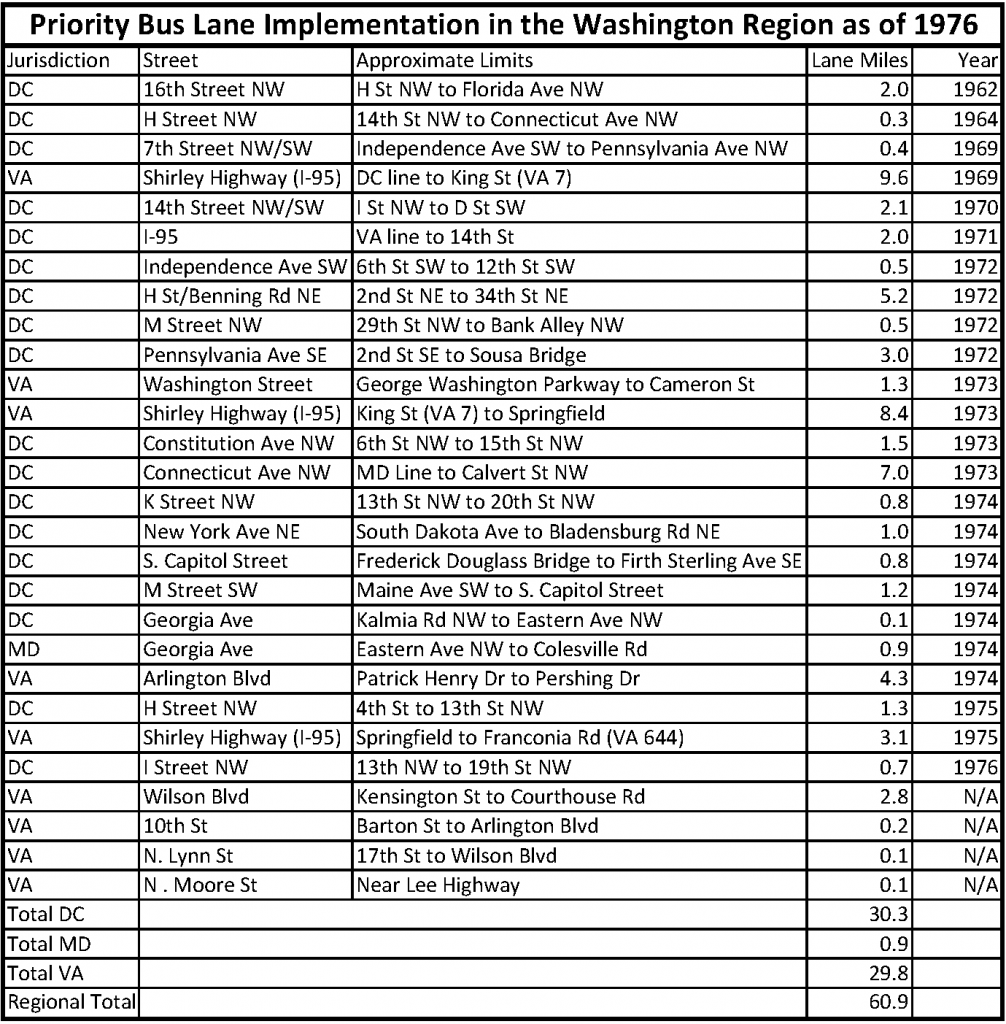We Had Bus Lanes a Half Century Ago and We Can Again
Despite having two million fewer people, our region used to have 60 miles of bus lanes. It’s time to revive them.
Did We Really Have That Many Bus Lanes?
Yes. In the 1960s and 70s before Metrorail was built, Washington and its surrounding inner suburbs relied heavily on its bus system to get around, with very frequent service on a number of major streets. According to our records (linked at the bottom of this post), the first bus-only lane was installed in 1962 on 16th Street NW in DC, generally between H Street NW and Florida Avenue NW [DDOT Fact Sheet, p. 6]. This was followed by dozens of miles of rush-hour and full-time installations, as shown in the map and table below. Streets in red indicate bus lanes that were implemented as of 1976, while streets in black and blue represent bus lanes that were planned but, to our knowledge, never put in place.
Why Were They Installed?
Generally, the lanes were put in place to:
- support increasing bus ridership,
- reduce traffic congestion on city streets,
- accommodate economic growth without increasing parking supply, and
- respond to new federal rules established to improve the poor air quality of the time.
How Did They Perform?
Along the two exclusive bus lanes of the Shirley Highway (I-95/395) in Northern Virgina, ridership increased 250% from 1971 to 1974 [Shirley, p. 4], beating forecasts by almost 50%. At that time, the Shirley Busway carried about the same numbers of morning rush hour commuters in the two reversible, peak-direction bus lanes as the all cars in the 3 other inbound general purpose lanes combined [Shirley, p. 5]. Along Arlington Blvd (US-50) in Fairfax and Arlington Counties, bus speeds and ridership increased by 21% and 10% [NVTC, p. 1], respectively, in just the first four months after the bus lanes were installed. The lanes cost $1.3 million, or about $6.8 million in today dollars. In 1976, the District Department of Transportation estimated that it would have taken 185,000 cars (and parking spaces to store them) to move the 277,000 people transported on 5,540 buses just during the time of bus lane operations [DDOT Fact Sheet, p. 7]. Although the benefits were clear, correspondence hints there were some also challenges involved in enforcing the lane restrictions along city streets, which can still be a challenge today.
What Happened To Them?
In some cases policy changes favoring auto travel were made which ended the bus-only lane restrictions. For example, after several years of bus-only operation on the Shirley Highway, high-occupancy vehicles (HOV4+) were allowed use of the busway. This led to a reduction in demand for service and eventually to the HOV 3+ and part time general traffic use we see on the reversible lanes today. More often, Metrorail lines were built underneath or near many the streets where high volume bus corridors operated, enabling the routes to be truncated at rail stations to feed the newly opened rail lines. In this way the gradual construction and operation of the Metrorail System allowed the new heavy rail lines to handle the higher passenger loads they were built to accommodate, which in turn reduced the demand for bus service in many corridors where bus lanes previously were installed.
We Did This Before and Know It Can Work Today
Not only did we successfully install bus lanes before, some of the same streets which need the lanes today, notably H and I Streets NW, and 16th Street NW, already had the bus lanes many decades ago. But the local DOTs, and not Metro, own and control the streets and must make the decisions to install priority bus lanes. However, it’s instructive that that every state transportation agency in the region has implemented bus lanes before, and acknowledged the fundamental efficiency benefits [DDOT Fact Sheet, p. 7] of bus lanes for riders and drivers alike [VDOT, p. 2]. With an increasingly urbanizing region, constrained street space, full buses slowed on congested streets, and an increasingly crowded Metrorail system it’s time to act now. Metro is working with its local partners through our Momentum Plan Metro 2025 Initiatives like the Priority Corridor Network, to develop bus-only lanes and other priority treatments along heavily traveled frequent service bus corridors. If you support bus lanes and other transit improvements, endorse Momentum and contact your local department of transportation.
References:
VDOT Press Release on Arlington Blvd Bus Lanes, Nov. 1974
NVTC Memo on Arlington Blvd Bus Lane Performance, Mar. 1975
Shirley Busway Final Report – selected pages, Sept. 1976
DDOT Bus Priority Lanes Fact Sheet, Oct. 1976
DDOT Bus Lane Signage Memo, Nov. 1976
WMATA Memo on Bus Priority Lanes in MD & VA, Nov. 1976





Thank you Dan and Jonathan (WMATA). When we started pushing for bus improvements in 2013, Metro’s bus director Jim Hamre told us about this and I’m glad Jonathan was able to find and document this.
Not only is there successful precedent in various other US (and foreign) cities, but we have precedent here in DC itself – ON SIXTEENTH STREET ITSELF!
DDOT has promised to move forward with the implementation process on 16th Street (starting with an environmental study), BUT:
1) DDOT has refused to commit to starting this process/study. They said it will be sometime in FY2015, but they owe the residents a START DATE. DDOT needs to issue its RFP asap – preferably this summer.
2) ALTERNATIVELY, DDOT could/should start with a PILOT in the section with 5 lanes already (Arkansas to W). Former DDOT officials have told me that this is possible without a study.
Fundamentally, DC government has already done this before on 16th Street and the time has come to try it again. Remember, this is neither costly nor permanent.
DDOT says they want to start with wider rush-hour parking restrictions. But there is no reason we cannot do both. They also have suggested (in their MoveDC plan) that millions be spent on making 16th Street a high capacity bus route.
I recently testified before the DC Council (http://www.washingtonpost.com/blogs/dr-gridlock/wp/2014/06/27/ddot-urged-to-act-on-16th-street-bus-lane-again/) that:
“residents are glad moveDC would make investments on bus service, but don’t want the long-term plan to delay more immediate plans for 16th Street. An outspoken advocate for a bus lane along 16th Street, Putta urged the the city to move forward with a bus lane feasibility study for the corridor.”
7 of 13 councilmembers have expressed public support, including both major mayoral candidates (I’ve not asked Ms. Schwatz yet). It’s time to act, DDOT.
We stand ready to help. Thank you.
Kishan Putta
My recollection is that when I moved to Bethesda in 1982 there were diamond lanes (as they were then known) on Wisconsin Avenue as well as Connecticut.
@ Ben Ross, It’s certainly possible that there were other places with bus lanes that may have been installed after 1976, but we did not have those records readily available, so they weren’t included in our map. Notice that there is a blue line along Wisconsin Ave indicated a lane was proposed there.
It’s great to see that there is strong local precedent for bus lanes. We need them on Wisconsin Avenue too. We have one of the busiest lines in the city and the frequency of buses on our corridor hasn’t improved in years while ridership often overflows buses. Additionally the traffic on Wisconsin is very congested and our buses are completely unreliable based on their schedules. Bus lanes would go a long way to improve the quality of life all along Wisconsin.
Go to page W3 – 122. DDOT mentioned in this 2013 report that there is a bus lane on CT Ave NW.
http://ddotfiles.com/SpeedCameras/Ward3_Planned/ConnAve_MilitaryRd_NW.pdf @Jonathan
HEY JONATHAN I WAITING FOR EX-DCTRANSIT WMATA METROBUSES,EX-WMA TRANSIT WMATA METROBUSES,EX-AB&W TRANSIT WMATA METROBUSES,EX-WVM TRANSIT WMATA METROBUSES,1974 WMATA AM GENERAL METROBUSES,AND 1979 WMATA GMC RTS METROBUSES TO RETURNED VERY SOON SO SOME OF THE PEOPLE WILL GET TO RIDE ON THEM AND I WILL GET TO RIDE ON THEM AND THEY WILL BE FOLLOWING THE NEW BUSES ON ALL ROUTES.
JONATHAN THEY NEED TO FIXED THE DC TRANSIT BUS UP GOOD IT BEEN SITING IN THE WOODS FOR A WHILE METRO NEED TO GO OUT SOMEWHERE IN VIRGINIA AND FIXED IT UP AND BRING IT TO SHEPHARD PARKWAY METROBUS DIVISION AND THEY WILL PUT THE SIGN SAY METROBUS ON IT PUT PAINT IT ORANGE AND GREEN DC TRANSIT COLOR.
GOOD AFTERNOON HOW ARE YOU DOING I CHECKED OUT THESE HISTORIC METROBUSES THESE ARE NICE I WISH THEY WILL BRING THEM ALL BACK INCLUDING 1968 EX-DC TRANSIT FLXIBLE NEW LOOKS.
HEY JONATHAN I SENT METRO AN EMAIL I WAS LETTING THEM KNOW WE ALL WANT THE OLD SCHOOL BACK EX-DC TRANSIT/METROBUSES,EX-WMA TRANSIT/METROBUSES,EX-AB&W TRANSIT/METROBUSES,EX-WVM TRANSIT/METROBUSES,1974 WMATA AM GENERAL METROBUSES,AND 1979 GMC RTS WMATA METROBUSES WILL BE RETURNING SOON BACK TO ALL ROUTES SINCE THEY BRINGING BACK THE BUS LANES FOR DC MD AND VA.